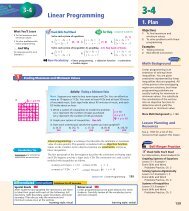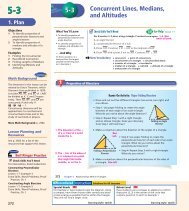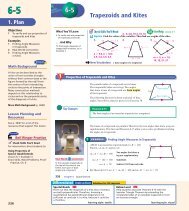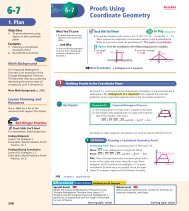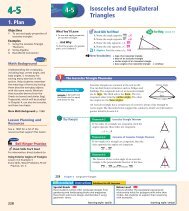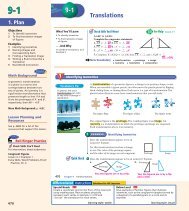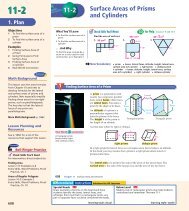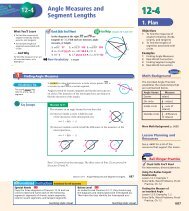Section 9.5
Section 9.5
Section 9.5
You also want an ePaper? Increase the reach of your titles
YUMPU automatically turns print PDFs into web optimized ePapers that Google loves.
9-5<br />
1. Plan<br />
Objectives<br />
1 To locate dilation images<br />
of figures<br />
Examples<br />
1 Finding a Scale Factor<br />
2 Real-World Connection<br />
3 Graphing Dilation Images<br />
Math Background<br />
Dilations map figures onto similar<br />
figures. A dilation may or may not<br />
have an invariant point that maps<br />
onto itself but is uniquely<br />
determined by its effect on any<br />
two given points.<br />
More Math Background: p. 468D<br />
Lesson Planning and<br />
Resources<br />
See p. 468E for a list of the<br />
resources that support this lesson.<br />
PowerPoint<br />
498<br />
Bell Ringer Practice<br />
Check Skills You’ll Need<br />
For intervention, direct students to:<br />
Ratios and Proportions<br />
Lesson 7-1: Example 4<br />
Extra Skills, Word Problems, Proof<br />
Practice, Ch. 7<br />
9-5<br />
What You’ll Learn<br />
• To locate dilation images of<br />
figures<br />
. . . And Why<br />
To find the dimensions of a<br />
car using the dimensions of<br />
its model, as in Example 2<br />
1 Locating Dilation Images<br />
Real-World<br />
Connection<br />
Look closely at your pupil<br />
in a mirror, and you can<br />
watch it dilate.<br />
1 A B C D E<br />
2 A B C D E<br />
3 A B C D E<br />
4 A B C D E<br />
5 A B C D E<br />
B C D E<br />
Test-Taking Tip<br />
When finding a scale<br />
factor, note first<br />
whether the dilation<br />
is an enlargement or<br />
a reduction.<br />
498 Chapter 9 Transformations<br />
1<br />
Dilations<br />
Check Skills You’ll Need GO for Help<br />
1<br />
Lesson 7-1<br />
2. 2 in. by 22 in.<br />
1<br />
Determine the scale drawing dimensions of a room using a scale of 4 in. ≠ 1 ft.<br />
1. kitchen: 12 ft by 16 ft 3 in. by 4 in. 2. bedroom: 8 ft by 10 ft<br />
3. laundry room: 6 ft by 9 ft<br />
1 1<br />
12 in. by 24 in.<br />
New Vocabulary • dilation<br />
4. bathroom: 5 ft by 7 ft<br />
1 3<br />
14 in. by 14 in.<br />
• enlargement • reduction<br />
A is a transformation whose preimage and image are similar. Thus, a<br />
dilation is a similarity transformation. It is not, in general, an isometry.<br />
Every dilation has a center and a scale factor n, n . 0. The scale factor describes<br />
the size change from the original figure to the image.<br />
To find a dilation with center C and scale factor n,<br />
you can use the following two rules.<br />
• The image of C is itself (that is, C9 = C).<br />
• For any point R, R9 is on CR and CR9 = n ? CR.<br />
The dilation is an enlargement if the scale factor is<br />
greater than 1. The dilation is a reduction if the scale<br />
factor is between 0 and 1.<br />
B<br />
C<br />
F G<br />
B<br />
2<br />
C 4<br />
F<br />
C<br />
E<br />
G<br />
H<br />
A= A D D<br />
Enlargement<br />
Center A, scale factor 2<br />
E<br />
Reduction<br />
Center C, scale factor 1<br />
4<br />
H<br />
)<br />
dilation<br />
n • CR<br />
R<br />
R<br />
C = C<br />
Center<br />
EXAMPLE<br />
Special Needs L1<br />
Review the distinctions between similar and<br />
congruent figures. Then show how a dilation needs<br />
both a center and a scale factor by drawing lines that<br />
pass through each vertex and the center of dilation.<br />
Finding a Scale Factor<br />
The blue triangle is a dilation image of the red<br />
triangle. Describe the dilation.<br />
The center is X. The image is larger than the<br />
preimage, so the dilation is an enlargement.<br />
XrTr<br />
=<br />
4 1 8<br />
= 3<br />
XT 4<br />
The dilation has center X and scale factor 3.<br />
R<br />
R T<br />
4<br />
X X<br />
Below Level L2<br />
Before presenting dilations, review the definition of<br />
similar polygons and the postulates and theorems<br />
about similar triangles.<br />
learning style: visual learning style: verbal<br />
8<br />
T
Z<br />
Z<br />
2<br />
2<br />
4<br />
6<br />
y<br />
G<br />
Quick Check<br />
Quick Check<br />
1 1<br />
3. P9(1, 0), Z9(– 2 , 4),<br />
1<br />
G9( 2 , –1)<br />
y<br />
1<br />
Z<br />
x<br />
1 O 2<br />
1<br />
G<br />
P 4<br />
x<br />
P<br />
G<br />
P<br />
Quick Check<br />
1 The blue quadrilateral is a dilation image of the<br />
red quadrilateral. Describe the dilation.<br />
The dilation is a reduction with center<br />
(0, 0) and scale factor .<br />
1<br />
2<br />
2<br />
3<br />
Scale factors help you understand scale models, both large and small.<br />
EXAMPLE Real-World Connection<br />
Scale Models The packaging lists a model car’s length as 7.6 cm. It also gives the<br />
scale as 1 ; 63. What is the length of the actual car?<br />
To “enlarge” the model car to the actual car, use the scale factor 63. Multiply 7.6 cm<br />
by 63 to get 478.8 cm, or about 4.8 m, for the length of the actual car.<br />
2 The height of a tractor-trailer truck is 4.2 m. The scale factor for a model of the truck<br />
1<br />
is 54.<br />
Find the height of the model to the nearest centimeter. 8 cm<br />
Suppose a dilation is centered at the origin. You can find the dilation image of a<br />
point by multiplying its coordinates by the scale factor.<br />
Scale factor 4, (x, y) (4x, 4y)<br />
4<br />
2<br />
O<br />
y<br />
A(2, 1)<br />
A'(8, 4)<br />
2 4 6 8<br />
Advanced Learners L4<br />
Students can use the definition of dilation, and<br />
triangle similarity postulates and theorems, to prove<br />
that the trapezoids above Example 1 are similar.<br />
To dilate a triangle from the origin, find the dilation images of its vertices.<br />
EXAMPLE<br />
Graphing Dilation Images<br />
Multiple Choice #PZG has vertices P(2, 0), Z-1,<br />
1<br />
2<br />
, and<br />
G(1, -2). What are the coordinates of the image of P for a<br />
dilation with center (0, 0) and scale factor 3?<br />
(5, 3) (6, 0)<br />
(<br />
2<br />
3<br />
, 0) (3, -6)<br />
The scale factor is 3, so use the rule (x, y) S (3x,3y).<br />
1<br />
1 1<br />
Scale factor 3,<br />
(x, y) ( 3 x, 3 y)<br />
y<br />
O 2 4 6 8 x<br />
2<br />
B'(3, 2)<br />
4<br />
P(2, 0) S Pr(3 ? 2, 3 ? 0) , or Pr(6, 0) . The correct answer is B.<br />
x<br />
B(9, 6)<br />
Z9 is 3 ? (21), 3 ? and G9 is (3 ? 1, 3 ? (22)) , so the vertices of the enlargement<br />
at the left are P9(6, 0), Z9-3,<br />
3<br />
2<br />
, and G9(3, -6).<br />
3<br />
1<br />
Find the image of #PZG for a dilation with center (0, 0) and scale factor 2.<br />
Draw the reduction. See left above.<br />
1 2<br />
learning style: verbal<br />
6<br />
y<br />
2 O 2 4<br />
M<br />
3<br />
M<br />
J<br />
J<br />
K<br />
L<br />
Lesson 9-5 Dilations 499<br />
2<br />
y<br />
Z P<br />
2 1<br />
2<br />
English Language Learners ELL<br />
Point out that a dilation scale factor is simply a<br />
multiplier. The dilation is an enlargement for<br />
a multiplier greater than 1, and a reduction<br />
for a multiplier between 0 and 1.<br />
G<br />
K<br />
x<br />
x<br />
L<br />
learning style: verbal<br />
2. Teach<br />
Guided Instruction<br />
Connection to Biology<br />
Ask: When your pupil dilates, is<br />
the dilation an enlargement or a<br />
reduction? enlargement<br />
3<br />
EXAMPLE<br />
Math Tip<br />
Scalar multiplication is used only<br />
for dilations centered at the<br />
origin. Have students try to find<br />
the image with center P to see<br />
why this is so.<br />
PowerPoint<br />
Additional Examples<br />
1 Circle A with a 3-cm diameter<br />
and center C is a dilation of<br />
concentric circle B with an 8-cm<br />
diameter. Describe the dilation.<br />
reduction with center C and<br />
3<br />
scale factor 8<br />
2 The scale factor on a museum’s<br />
floor plan is 1 : 200. The length<br />
and width on the drawing are<br />
8 in. and 6 in. Find the actual<br />
dimensions in feet and inches.<br />
133 ft, 4 in. by 100 ft<br />
3 ABC has vertices A(-2, -3),<br />
B(0, 4), and C(6, -12). What are<br />
the coordinates of the image of<br />
ABC for a dilation with center<br />
(0, 0) and scale factor 0.75?<br />
A(–1.5, –2.25), B(0, 3),<br />
C(4.5, –9)<br />
Resources<br />
• Daily Notetaking Guide 9-5 L3<br />
• Daily Notetaking Guide 9-5—<br />
Adapted Instruction L1<br />
Closure<br />
Draw square ABCD, a dilation<br />
image of ABCD with center A<br />
and scale factor 3, and a dilation<br />
image of ABCD with center C<br />
1<br />
and scale factor 2.<br />
Check<br />
students’ drawings.<br />
499
3. Practice<br />
Assignment Guide<br />
1 A B 1-61<br />
C Challenge 62-66<br />
Test Prep 67-71<br />
Mixed Review 72-81<br />
Homework Quick Check<br />
To check students’ understanding<br />
of key skills and concepts, go over<br />
Exercises 8, 16, 35, 42, 56.<br />
Error Prevention!<br />
Exercises 1–9 Students should be<br />
careful not to describe dilations as<br />
“as big as” or “bigger than” but<br />
to give the precise scale factor.<br />
Exercises 10–14 Ask students who<br />
have model railroads to bring cars<br />
to class to show other students.<br />
Alternative Method<br />
Exercises 15–17 Organize the<br />
class into two groups. Have one<br />
group copy the graphs and draw<br />
segments to find the images<br />
and the other group use scalar<br />
multiplication to find the images.<br />
Discuss the advantages of each<br />
method.<br />
GPS<br />
500<br />
Guided Problem Solving<br />
Enrichment<br />
Reteaching<br />
Adapted Practice<br />
Name Class Date<br />
Practice 9-5<br />
Find the area of each polygon. Round your answers to the nearest tenth.<br />
1. an equilateral triangle with apothem 5.8 cm<br />
2. a square with radius 17 ft<br />
3. a regular hexagon with apothem 19 mm<br />
4. a regular pentagon with radius 9 m<br />
5. a regular octagon with radius 20 in.<br />
6. a regular hexagon with apothem 11 cm<br />
7. a regular decagon with apothem 10 in.<br />
8. a square with radius 9 cm<br />
Trigonometry and Area<br />
Find the area of each triangle. Round your answers to the nearest tenth.<br />
9. 10. 11.<br />
12. 13. 14.<br />
28 in. 32 in.<br />
15. 10 cm<br />
35<br />
19 cm<br />
16. 5 ft<br />
65<br />
4 ft<br />
17. 15 m<br />
46<br />
59<br />
63<br />
6.5 m<br />
13 m<br />
9 mi<br />
42<br />
10 mi<br />
38 18 km<br />
10 km<br />
34 in.<br />
6 mm<br />
46<br />
54<br />
26 in.<br />
4.5 mm<br />
Find the area of each regular polygon to the nearest tenth.<br />
18. a triangular dog pen with apothem 4 m<br />
19. a hexagonal swimming pool cover with radius 5 ft<br />
© Pearson Education, Inc. All rights reserved. Practice<br />
20. an octagonal floor of a gazebo with apothem 6 ft<br />
21. a square deck with radius 2 m<br />
22. a hexagonal patio with apothem 4 ft<br />
15 m<br />
L3<br />
L4<br />
L2<br />
L1<br />
L3<br />
EXERCISES<br />
For more exercises, see Extra Skill, Word Problem, and Proof Practice.<br />
Practice and Problem Solving<br />
A<br />
Practice by Example<br />
GO for<br />
Help<br />
Example 1<br />
(page 498)<br />
1. enlargement; center<br />
A, scale factor<br />
2. enlargement; center C,<br />
scale factor 3<br />
3. enlargement; center<br />
R, scale factor<br />
4. reduction; center K,<br />
scale factor<br />
5. reduction; center L,<br />
scale factor<br />
6. enlargement; center<br />
M, scale factor 2<br />
7. reduction; center (0, 0),<br />
scale factor 1 3<br />
2<br />
3<br />
2<br />
1<br />
3<br />
1<br />
3<br />
2<br />
Example 2<br />
(page 499)<br />
8. enlargement; center<br />
(0, 0), scale factor 2<br />
9. enlargement; center<br />
(0, 0), scale factor 3 2<br />
Example 3<br />
(page 499)<br />
500 Chapter 9 Transformations<br />
The blue figure is a dilation image of the red figure. Describe the dilation.<br />
1.<br />
1–9. See left.<br />
2. 3.<br />
2<br />
A<br />
4. 5. 6.<br />
7. y<br />
8. y<br />
9.<br />
6<br />
4<br />
2<br />
4<br />
6<br />
O 2 4<br />
K<br />
x<br />
C<br />
3<br />
1<br />
x<br />
2<br />
1<br />
O 3<br />
Model Railroads The table shows scales for<br />
Model Railroad Scales<br />
different types of model railroads. For each<br />
model in Exercises 10–12, what would be the<br />
Scale Name Scale Ratio<br />
actual measurement?<br />
121.94 in.<br />
10. An HO-scale tank car is 1.4 in. high.<br />
N<br />
HO<br />
1 : 160<br />
1 : 87.1<br />
11. An S-scale boxcar has length 8 in. 512 in.<br />
S<br />
1 : 64<br />
12. A model of an engineer in a G-scale model O<br />
1 : 48<br />
train layout is 3 in. tall. 67.5 in.<br />
13. A diesel engine is 60 feet long. How long is<br />
its O-scale model? 1.25 ft<br />
G<br />
1 : 22.5<br />
14. Actual railroad tracks are 4 ft 8.5 in. apart. How far apart are N-scale tracks?<br />
0.35 in.<br />
Find the image of kPQR for a dilation with center (0, 0) and the scale factor given.<br />
Draw the image. 15–17. See back of book.<br />
15. y Q<br />
16. Q y 17.<br />
Q y<br />
2<br />
x<br />
P<br />
4<br />
2<br />
O x<br />
1<br />
P<br />
1<br />
O 2 x<br />
O<br />
2<br />
P<br />
3<br />
R<br />
3 R<br />
3<br />
R<br />
scale factor 3 scale factor 10 scale factor 3 4<br />
L<br />
9<br />
R<br />
4<br />
4<br />
2<br />
M<br />
y<br />
4<br />
O<br />
x
B<br />
Apply Your Skills<br />
Exercise 41<br />
27. Q9(–9, 12), W9(9, 15),<br />
T9(9, 3), R9(–6, –3)<br />
28. Q9(–6, 8), W9(6, 10),<br />
T9(6, 2), R9(–4, –2)<br />
A dilation has center (0, 0). Find the image of each point for the scale factor given.<br />
18. D(1, -5); 2 D9(2, –10) 19. L(-3, 0); 5 L9(–15, 0) 20. A(-6, 2); 1.5<br />
21. T(0, 6); 3 T9(0, 18) 22. M(0, 0); 10 M9(0, 0) 23. N(-4, -7); 0.1<br />
24. F(-3, -2); 25. B<br />
5<br />
;<br />
1<br />
!3<br />
4 10<br />
26. Q6,<br />
2<br />
; !6<br />
Find the image of QRTW for a dilation with center (0, 0)<br />
y<br />
W<br />
and the scale factor given.<br />
Q<br />
4<br />
27. 3 28. 2 29.<br />
1<br />
30.<br />
1<br />
2<br />
4<br />
2<br />
31. 0.6 32. 0.9 33. 10 34. 100<br />
T<br />
3 O 2 x<br />
35. Writing An equilateral triangle has 4-in. sides. Describe 1<br />
R<br />
its image for a dilation with scale factor 2.5. Explain.<br />
36. Multiple Choice #D9E9F9 is a dilation of #DEF<br />
with center (0, 0). Which of the following<br />
statements is not true? B<br />
#DEF and #D9E9F9 are similar.<br />
m&F9D9E9 =<br />
1<br />
3<br />
? m/FDE<br />
The scale factor of the dilaton is<br />
1<br />
3<br />
.<br />
/EFD > /ErFrDr<br />
, 22 A9(–9, 3)<br />
1<br />
3 F9(–1, – )<br />
3<br />
27–34. See margin.<br />
The image has side lengths 10 in. and l measures 60.<br />
y<br />
D<br />
4<br />
E<br />
6 4<br />
D<br />
E<br />
2 O F<br />
2<br />
x<br />
F<br />
2<br />
N9(–0.4, –0.7)<br />
3<br />
B9(<br />
1<br />
, –<br />
1<br />
8 15<br />
)<br />
3!2<br />
Q9(6 !6,<br />
2<br />
)<br />
Coordinate Geometry Graph MNPQ and its image 37–40. See back of book.<br />
M9N9P9Q9 for a dilation with center (0, 0) and the scale factor given.<br />
37. M(-1, -1), N(1, -2), P(1, 2), Q(-1, 3); scale factor 2<br />
38. M(1, 3), N(-3, 3), P(-5, -3), Q(-1, -3); scale factor 3<br />
39. M(0, 0), N(4, 0), P(6, -2), Q(-2, -2); scale factor<br />
1<br />
2<br />
40. M(2, 6), N(-4, 10), P(-4, -8), Q(-2, -12); scale factor<br />
1<br />
4<br />
41. Open-Ended Use the dilation command in geometry software or drawing<br />
software to create a design that involves repeated dilations. The software<br />
will prompt you to specify a center of dilation and a scale factor. Print<br />
your design and color it. Feel free to use other transformations along<br />
with dilations. Check students’ work.<br />
42. Copy Reduction Your copy of your family crest is 4.5 in. wide. You need a<br />
reduced copy for the front page of the family newsletter. The copy must fit in a<br />
space 1.8 in. wide. What scale factor should you use on the copy machine?<br />
Use a scale factor of .<br />
A dilation maps kHIJ to kH9I9J9. Find the missing values.<br />
43. HI = 8 in. 44. HI = 7 cm 45. HI = j ft 32<br />
IJ = 5 in. IJ = 7 cm IJ = 30 ft<br />
HJ = 6 in. HJ = j cm 12 HJ = 24 ft<br />
H9I9= 16 in. H9I9= 5.25 cm H9I9= 8 ft<br />
I9J9 = j in. 10 I9J9 = j cm 5.25 I9J9 = j ft 7.5<br />
H9J9 = j in. 12 H9J9 = 9 cm H9J9 = 6 ft<br />
2<br />
5<br />
46. Error Analysis Brendan says that when a rectangle with length 6 cm and width<br />
4 cm is dilated by a scale factor of 2, the perimeter and area of the rectangle are<br />
doubled. Explain what is incorrect about Brendan’s statement.<br />
The perimeter is doubled but the area is multiplied by 4.<br />
3 3 5<br />
29. Q91– 2<br />
, 22, W91 2 , 2 2,<br />
3 1 1<br />
T91 2 , 22,<br />
R91–1, – 22<br />
3 3 5<br />
30. Q91– 4 , 12, W91 4 , 4 2,<br />
3 1 1 1<br />
T91 4 , 42,<br />
R91– 2,<br />
– 42<br />
Lesson 9-5 Dilations 501<br />
31. Q91–1.8, 2.42, W911.8, 32,<br />
T911.8, 0.62, R91–1.2,<br />
–0.62<br />
32. Q91–2.7, 3.62, W912.7, 4.52,<br />
T912.7, 0.92, R91–1.8, –0.92<br />
Exercise 36 To help students<br />
interpret the question correctly,<br />
ask: What are you looking for?<br />
The statement that is not true.<br />
Teaching Tip<br />
Exercise 41 Before students begin,<br />
discuss how to create each figure<br />
using dilations, rotations, and<br />
translations.<br />
Diversity<br />
Exercise 42 Students unfamiliar<br />
with heraldry may not know what<br />
a family crest or coat of arms is.<br />
Internet genealogy sites provide<br />
many such examples for students<br />
to examine.<br />
Exercise 46 If necessary, review<br />
Theorem 8-6: If the similarity<br />
ratio of two similar figures is<br />
a:b,then (1) the ratio of their<br />
perimeters is a :b and (2) the<br />
ratio of their areas is a 2 :b 2 .<br />
Exercises 49–52 Exercises 49, 50,<br />
and 52 can be done with compass<br />
and straightedge. Exercise 51<br />
requires a ruler.<br />
Exercises 57–61 Use these<br />
exercises for class discussion to<br />
assess students’ understanding of<br />
the lesson. If answers vary, have<br />
students explain their reasons to<br />
one another.<br />
Connection to Film<br />
Exercise 62 The ratio of the<br />
perimeters of the similar triangles<br />
is also 3 in. : 1 ft. Point out that<br />
the flashlight models a film<br />
projector, the small rectangle<br />
models a film slide, and the large<br />
rectangle models its projection<br />
on a screen.<br />
Visual Learners<br />
Exercise 63 Suggest that students<br />
place a tracing of AB and ArBr<br />
over a coordinate grid.<br />
33. Q91–30, 402, W9130, 502,<br />
T9130, 102, R91–20, –102<br />
34. Q91–300, 4002,<br />
W91300, 5002,<br />
T91300, 1002,<br />
R91–200, –1002<br />
501
4. Assess & Reteach<br />
PowerPoint<br />
502<br />
Lesson Quiz<br />
1. A model is a reduction<br />
of a real tractor by the scale<br />
factor of 1 : 16. Its dimensions<br />
are 1.2 ft by<br />
0.6 ft by 0.625 ft. Find the<br />
actual dimensions of the<br />
tractor. 19.2 ft by 9.6 ft<br />
by 10 ft<br />
For Exercises 2 and 3, kXYZ has<br />
vertices X(3, 1), Y(2, –4), and<br />
Z(–2, 0).<br />
2. Use scalar multiplication to<br />
find the image of XYZ for a<br />
dilation with center (0, 0) and<br />
scale factor 2.5. X(7.5, 2.5),<br />
Y(5, –10), Z(–5, 0)<br />
3. Draw and label the preimage<br />
and image.<br />
y<br />
6<br />
4 X'<br />
2<br />
Z' O X<br />
Z<br />
2 2 4 6 8<br />
For Exercises 4 and 5, kDIL is a<br />
dilation image of kDAT.<br />
I<br />
A<br />
4<br />
6<br />
8<br />
10<br />
D<br />
Y<br />
2 m<br />
T<br />
Y'<br />
6 m<br />
4. Identify the center of dilation.<br />
D<br />
5. Find the scale factor. 4<br />
Alternative Assessment<br />
Have each student draw and label<br />
a triangle with vertices A, B, and<br />
C; choose a scale factor; and then<br />
exchange papers with a partner<br />
and draw the dilation image of<br />
the partner’s triangle, using A as<br />
the center. After drawing the<br />
images, have partners compare<br />
the pre-images and images and<br />
check each other’s work.<br />
L<br />
GO<br />
51.<br />
B<br />
T T<br />
B A<br />
Real-World<br />
nline<br />
Homework Help<br />
Visit: PHSchool.com<br />
Web Code: aue-0905<br />
C<br />
A<br />
O<br />
Connection<br />
An overhead projection is a<br />
dilation only when the mirror<br />
in the head is tilted at a 458<br />
angle. Turning the head<br />
distorts the images.<br />
Challenge<br />
62. Each vertex is 1 ft<br />
from the light.<br />
63. Connect<br />
corresponding points<br />
A and A9 and B and<br />
B9. Extend AA9 and<br />
BB9 until they<br />
intersect at the center<br />
of dilation. The scale<br />
factor is the length of<br />
A9B9 divided by the<br />
length of AB.<br />
502 Chapter 9 Transformations<br />
The diagram at the right shows kLMN and its<br />
image kL9M9N9 for a dilation with center P.<br />
47. Algebra Find the values of x and y.<br />
48. Evaluate y and 2y - 60. Explain why the two<br />
values must be equal. 60, 60; the two<br />
Copy kTBA and point O for each of Exercises 49–52. Draw the dilation image<br />
kT9B9A9 for the given center and scale factor.<br />
49. center O, scale factor<br />
50. center B, scale factor 3<br />
49–50.<br />
51. center T, scale factor See left.<br />
52. center O, scale factor 2<br />
53. Constructions Copy #GHI and point X onto your<br />
paper. Use a compass and straightedge to construct<br />
the image of #GHI for a dilation with center X and<br />
scale factor 2. See margin.<br />
Overhead Projection An overhead projector can dilate figures on transparencies.<br />
54. A segment on a transparency is 2 in. long. Its image on the screen is 2 ft long.<br />
What is the scale factor of the dilation? 12<br />
55. The height of a parallelogram on the transparency is 4 cm. The scale factor is 15.<br />
What is the height of the parallelogram on the screen? 60 cm<br />
56. The area of a square on the screen is 3 ft2 x<br />
1<br />
2<br />
T<br />
1<br />
3<br />
B<br />
O<br />
A<br />
I<br />
G H<br />
X<br />
. The scale factor is 16. What is the<br />
area of the square on the transparency?<br />
Write true or false for Exercises 57–61. Explain your answers. 57–61. See<br />
57. A dilation is an isometry. 58. A dilation changes orientation.<br />
59. A dilation with a scale factor greater than 1 is a reduction.<br />
60. For a dilation, corresponding angles of the image and preimage are congruent.<br />
61. A dilation image cannot have any points in common with its preimage.<br />
2 x 2<br />
L<br />
x ≠ 3; y ≠ 60<br />
4 L<br />
x<br />
2<br />
M<br />
P y N<br />
triangles are similar, so corresponding angles are congruent.<br />
x + 3<br />
M<br />
N<br />
(2y - 60)<br />
See back<br />
of book.<br />
See margin.<br />
ft<br />
margin p. 503.<br />
2 3<br />
GPS<br />
256<br />
62. A flashlight projects an image of<br />
B<br />
rectangle ABCD on a wall so that each<br />
B<br />
C<br />
vertex of ABCD is 3 ft away from the<br />
A C<br />
corresponding vertex of A9B9C9D9. The<br />
A<br />
D<br />
length of AB is 3 in. The length of ArBr is 1 ft. See left.<br />
D<br />
not to scale<br />
How far from each vertex of ABCD is the light?<br />
63. Critical Thinking You are given AB and its dilation image ArBr with A, B, A9,<br />
and B9 noncollinear. Explain how to find the center of dilation and scale factor.<br />
See left.<br />
Coordinate Geometry In the coordinate plane you can extend dilations to include<br />
scale factors that are negative numbers.<br />
a–c. See back of book.<br />
64. a. Graph #PQR with vertices P(1, 2), Q(3, 4), and R(4, 1).<br />
b. For a dilation centered at the origin with a scale factor of -3, multiply the<br />
coordinates in part (a) by -3. List the results as P9, Q9, and R9.<br />
c. Graph #P9Q9R9 on the same set of axes.<br />
52. T<br />
53.<br />
B<br />
B<br />
T<br />
A<br />
A<br />
O<br />
G G<br />
x<br />
I<br />
H<br />
I<br />
H
Problem Solving Hint<br />
For Exercise 65(b),<br />
recall the meaning of<br />
reflection in a line.<br />
Test Prep<br />
Gridded Response<br />
Mixed Review<br />
GO for<br />
Help<br />
Lesson 9-5<br />
Lesson 9-1<br />
Lesson 8-5<br />
lesson quiz, PHSchool.com, Web Code: aua-0905<br />
57. False; a dilation doesn’t<br />
map a segment to a O<br />
segment unless the<br />
scale factor is 1.<br />
65. a. A dilation with center at the origin and scale factor -1 (see Exercise 64)<br />
may be called a reflection in a point. For #PQR of Exercise 64, find the<br />
image #P9Q9R9 for such a dilation. P9(–1, –2), Q9(–3, –4), R9(–4, –1)<br />
b. Writing Explain why the dilation described in part (a) may be called<br />
a reflection in a point. Extend your explanation to a new definition of<br />
point symmetry. Compare your new definition with the definition given<br />
on page 493. See margin.<br />
66. Constructions Draw acute #ABC. Construct square DEFG so that DG is on<br />
AC,<br />
and E and F are on the other two sides of #ABC.(Hint: First, try the<br />
special case with a right angle at A and use a dilation.) See margin.<br />
67. A dilation maps #ABC onto #A9B9C9 with a scale factor of 0.3.<br />
If A9B9 = 312 m, what is AB in meters? 1040<br />
68. A dilation maps #CDE onto #C9D9E9. If CD = 7.5 ft, CE = 15 ft,<br />
D9E9 = 3.25 ft, and C9D9= 2.5 ft, what is DE in feet? 9.75<br />
69. A dilation maps #XYZ onto # X9Y9Z9. If XY = 4 m, YZ = 29 m,<br />
X9Z9 = 28.7 m, and Y9Z9 = 29.145 m, what is X9Y9 in meters? 4.02<br />
70. The center of dilation of quadrilateral ABCD<br />
is point X, as shown at the right. The length<br />
of a side of quadrilateral A9B9C9D9 is what<br />
percent of the length of the corresponding<br />
side of quadrilateral ABCD? 50<br />
71. A dilation maps #JKL onto #J9K9L9.<br />
If JK = 28 cm, KL = 52 cm, JL = 40.2 cm,<br />
and J9K9 = 616 cm, what is the scale factor? 22<br />
Coordinate Geometry A figure has a vertex at (–2, 7). If the figure has the given<br />
type of symmetry, state the coordinates of another vertex of the figure.<br />
72. line symmetry about the x-axis<br />
(–2, –7)<br />
74. point symmetry about the origin<br />
73. line symmetry about the y-axis<br />
(2, 7)<br />
75. line symmetry about the line y = x<br />
(2, –7)<br />
Write a rule for each translation.<br />
(7, –2)<br />
76. 0 units to the right, 4 units up<br />
(x, y) S (x, y ± 4)<br />
78. 3 units to the left, 6 units down<br />
77. 2 units to the left, 1 unit down<br />
(x, y) S (x – 2, y – 1)<br />
79. 8 units to the right, 10 units up<br />
(x, y) S (x – 3, y – 6) (x, y) S (x ± 8, y ± 10)<br />
For the angle of depression shown, find the value of x to the nearest tenth of a unit.<br />
80.<br />
25 ft<br />
26<br />
51.3 ft<br />
81.<br />
777.9 m<br />
x<br />
40<br />
500 m<br />
x<br />
58. False; a dilation does<br />
not change orientation.<br />
59. False; a dilation with a<br />
scale factor greater than<br />
1 is an enlargement.<br />
X<br />
8<br />
A<br />
D<br />
B<br />
A<br />
C<br />
8<br />
D<br />
Lesson 9-5 Dilations 503<br />
60. True; the image and<br />
preimage are similar,<br />
so the ' are O.<br />
61. False; if the center<br />
of dilation is on the<br />
preimage, it is also<br />
on the image.<br />
B<br />
C<br />
Test Prep<br />
A sheet of blank grids is available<br />
in the Test-Taking Strategies with<br />
Transparencies booklet. Give this<br />
sheet to students for practice with<br />
filling in the grids.<br />
Resources<br />
For additional practice with a<br />
variety of test item formats:<br />
• Standardized Test Prep, p. 527<br />
• Test-Taking Strategies, p. 522<br />
• Test-Taking Strategies with<br />
Transparencies<br />
65. b.Each point of the k is<br />
reflected in the origin,<br />
which is the point of<br />
reflection. Two figures<br />
are symmetrical with<br />
respect to a pt. P if P<br />
is the midpoint of<br />
each segment that<br />
connects two corr.<br />
points of the figure.<br />
66. Construct small square<br />
D9E9F9G9 so that is<br />
on (with D9 between<br />
A and G9), E9 is on ,<br />
and F9 is inside kABC.<br />
Draw AF to meet BC at<br />
F. Through F construct<br />
the line n to AC.<br />
Label<br />
its point of intersection<br />
with AB as E. Through E<br />
and F construct the lines<br />
# to AC.<br />
Label their<br />
points of intersection<br />
with AC as D and G<br />
respectively. DEFG is<br />
the desired square.<br />
S DrGr<br />
AC<br />
AB<br />
9<br />
503



